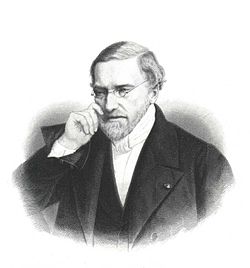Jean Victor Poncelet
| Jean-Victor Poncelet | |
|---|---|
 |
|
| Born |
1 July 1788 Metz, France |
| Died | 22 December 1867 (aged 79) Paris, France |
| Residence | Metz (later Paris) |
| Nationality | French |
| Fields | Mathematics, engineering |
| Institutions |
École d'application de l'artillerie of Metz University of Paris École Polytechnique |
| Alma mater | École Polytechnique |
| Academic advisors | Gaspard Monge |
| Known for | Traité des propriétés projectives des figures (1822), Introduction à la mécanique industrielle (1829) |
| Signature | |
Jean-Victor Poncelet (1 July 1788 – 22 December 1867) was a French engineer and mathematician who served most notably as the Commanding General of the École Polytechnique. He is considered a reviver of projective geometry, and his work Traité des propriétés projectives des figures is considered the first definitive text on the subject since Gérard Desargues' work on it in the 17th century. He later wrote an introduction to it: Applications d’analyse et de géométrie.
As a mathematician, his most notable work was in projective geometry, although an early collaboration with Charles Julien Brianchon provided a significant contribution to Feuerbach's theorem. He also made discoveries about projective harmonic conjugates; relating these to the poles and polar lines associated with conic sections. He developed the concept of parallel lines meeting at a point at infinity and defined the circular points at infinity that are on every circle of the plane. These discoveries led to the principle of duality, and the principle of continuity and also aided in the development of complex numbers.
As a military engineer, he served in Napoleon's campaign against the Russian Empire in 1812, in which he was captured and held prisoner until 1814. Later, he served as a professor of mechanics at the École d’application in his home town of Metz, during which time he published Introduction à la mécanique industrielle, a work he is famous for, and improved the design of turbines and water wheels. In 1837, a tenured 'Chaire de mécanique physique et expérimentale' was specially created for him at the Sorbonne (the University of Paris). In 1848, he became the commanding general of his alma mater, the École Polytechnique. He is honoured by having his name listed among notable French engineers and scientists displayed around the first stage of the Eiffel tower.
...
Wikipedia
